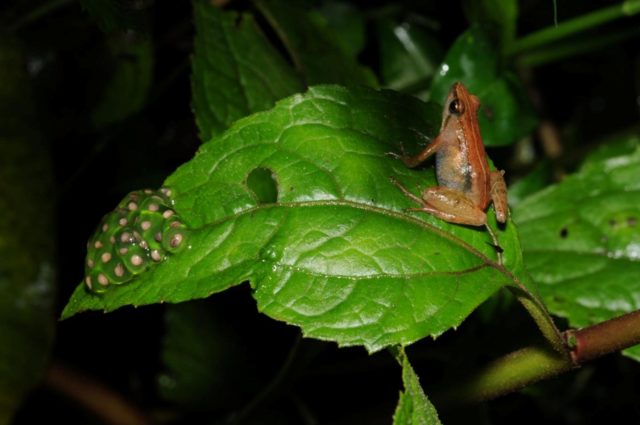haaretz | Dwarf puddle frog actually lives in trees, zoologists from NYU Abu Dhabi report from pond on the remote plateau An unknown species of frog has been discovered on a remote plateau in southwest Ethiopia. Even though it’s really small, the Bibita Mountain dwarf puddle frog was noticed lurking on leaves in one of Ethiopia’s last surviving patches of primary forest by scientists from NYU Abu Dhabi, who reported the find in ZooKeys this week.
It helps that leaves are green and the frog is golden in color, with a dark triangle between the eyes. Their eyes are golden, too.
Why would postdocs Sandra Goutte and Jacobo Reyes-Velasco slog up an isolated mountain plateau in the middle of nowhere, in the blistering heat of summer? Precisely because nobody – at least with a degree in zoology – had done so before, and the Ethiopian highlands are known for their biological diversity. The team members hadn’t explicitly thought they’d find a new species of puddle frog, but Mount Bibita had been on their minds for years.
“Untouched, isolated and unexplored: It had all the elements to spike our interest,” explains Reyes-Velasco, who initiated the exploration of the mountain. “We tried to reach Bibita in a previous expedition in 2016, without success. Last summer, we used a different route that brought us to higher elevation.” And they got their reward: The first-ever sighting of Phrynobatrachus bibita sp. nov.
The Bibitas have sexual dimorphism, but reversed. In this species the females are bigger than the males, who are a mere 1.7 centimeters (two-thirds of an inch) in length, on average, compared with the females’ 2 centimeters.
The little amphibians are slender, with long legs even by puddle frog standards. They also feature unusually elongated fingers and toes, without webbing, and a marked ridge on their tiny heads. Their little faces also have pointed snouts, not a must among frogs.

“Two rows of small warts form faint ridges between the eye and the scapular region,” the team writes, and the throat skin is tight, not loose.
“When we looked at the frogs, it was obvious that we had found a new species – they look so different from any Ethiopian species we had ever seen before!” says Goutte.
Genetic analysis of the frogs they euthanized (as they put it) back at the NYU Abu Dhabi campus led the team to realize that Phrynobatrachus bibita sp. nov. is genetically different to any other frog species in the region.
“The discovery of such a genetically distinct species in only a couple of days in this mountain is the perfect demonstration of how important it is to assess the biodiversity of this type of place. The Bibita Mountain probably has many more unknown species that await our discovery; it is essential for biologists to discover them in order to protect them and their habitat properly,” said NYU Abu Dhabi Program Head of Biology, and the paper’s lead researcher, Stéphane Boissinot, who has been working on the Ethiope frogs since 2010.
So, how common is this newly discovered froggie? It’s hard to say: Their mountain isn’t inhabited by humans above 1,900 meters, and all the specimens the scientists found hailed from one pond on the one mountaintop. But they weren’t in the water – they were in the trees. The females even lay their eggs in the trees, not in the water like most of their sisters in Phrynobatrachus. The one frog they found in the water was a male, whom they postulate was ribbiting for sex, as male frogs do.

























